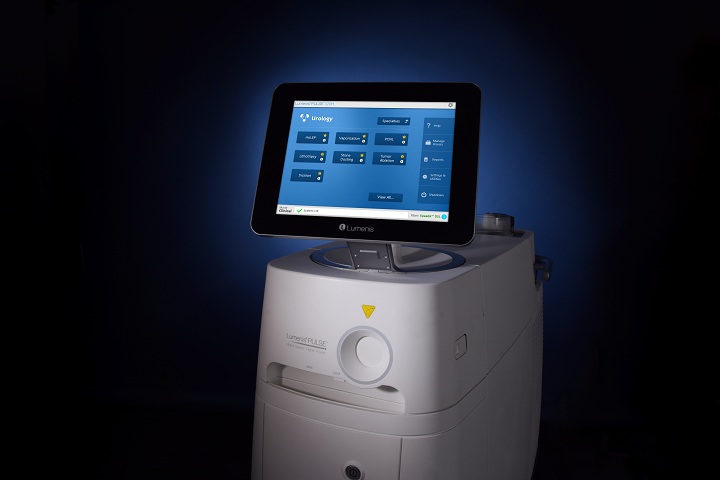Prostate enlargement, or benign prostatic hyperplasia (BPH), affects about half of men aged 51 to 60, with the risk increasing with age to include 90% of men over 80.1 The condition slows down and can even block flow of urine through the urethra, which can result in catheterization, repeated infections, and kidney deterioration. Although most BPH is initially controlled with medication, millions will need surgery to restore flow in the urethra. As a result, minimally invasive BPH procedures are some of the most common surgeries that urologists perform, and we are always developing new techniques for our patients.
In the last 10 years, as a procedure called holmium laser enucleation of the prostate (HoLEP) has become increasingly available, it has emerged as a versatile option for BPH because it can be safely employed for a broad range of prostate sizes, even the largest prostates.2 Patients who have relied on catheters or spent years making frequent bathroom trips are thrilled to have their quality of life restored, and HoLEP is the last BPH procedure a patient will need: the retreatment rate is only about 1%.3,4
A recent advance in laser technology for HoLEP called MOSES 2.0 (Lumenis) has made the procedure even more efficient with faster enucleation and hemostasis.5 Less blood loss and shorter time to achieve hemostasis may translate to not only saving time in the operating room, but also causing less blood in the urine after surgery.5 In fact, research has shown that surgeons can perform “M-HoLEP” as an outpatient procedure, rather than an overnight stay, because there is less blood in the urine—an exciting development that benefits both patients and busy hospitals.6
Until recently, there was little data to show the cost effects of this surgical approach and the ROI for this technology. We participated in two studies comparing the costs of HoLEP to M-HoLEP: one assessing ROI on the total cost of the laser,7 and the other examining the ROI of upgrading a laser to MOSES 2.0.8 Both found that M-HoLEP saved over $700 per case, with results that can be reproduced at other hospitals.
Significant Savings from 20% Less OR Time
To evaluate the cost-effectiveness of M-HoLEP from an operating room resource utilization standpoint, cases were selected for post-hoc cost analysis.7 A total of 60 patients with a prostate size ≥80 grams were randomized to undergo M-HoLEP or standard HoLEP using the same technique and laser settings for energy and frequency.
The mean time for HoLEP surgery was 126 minutes, compared to 101 minutes for M-HoLEP. Researchers determined that aside from surgical technology, no other variables significantly affected operative time. In the high-volume center where the study was held, shorter operating time per case resulted in a significant cost benefit.
Based on a standard cost of $37 per minute of operating room time, saving 25 minutes means saving $925, but other costs and savings were calculated. The MOSES 2.0 laser fiber cost $535 versus $406 for the SlimLine 550 laser fiber (Boston Scientific). Capital costs for the lasers themselves were significantly different ($220,000 for the Lumenis P120H with MOSES 2.0 vs. $145,130 for the Lumenis VersaPulse PowerSuite 100W). In the end, the mean cost of a HoLEP case was $5,068, while M-HoLEP was $4,272; costs per case increased to $5,213.13 and $4,492, respectively, after amortizing the laser device costs over 1000 procedures.
Based on the mean savings of $796 per case, a hospital that purchases a Lumenis P120H with MOSES 2.0 will recover the cost after about 277 M-HoLEP procedures. Thus, a surgeon who typically does 80 cases per year would create a return on investment in about 3.5 years.
Major Difference: No Overnight Stay
In another study, researchers using the Lumenis Pulse 120H laser compared the 30-day costs of HoLEP to M-HoLEP to explore the cost justification of purchasing a MOSES 2.0 upgrade.8 This retrospective analysis looked at 312 cases (120 HoLEP and 192 M-HoLEP) performed by a single experienced surgeon in an 18-month period before the upgrade and about 2 years after.
Patients had a mean age of 70 and prostate size of 115 grams. Most were ASA III (severe systemic disease). About 33% of patients had urinary retention, and 27.2% had an indwelling catheter. The two groups were similar; variables that did exist in preoperative status were found to have no significant effect on operative time or outcomes.
HoLEP patients had an overnight stay, but almost all M-HoLEP patients were discharged the same day—an important economic difference as well as a welcome advantage for patients. All patients had the same transfusion and complication rates at 30 days. Unplanned clinic visits and readmissions were the same. M-HoLEP patients had more ED visits (6.3% vs. 1.7%, p=0.0571). However, researchers noted these visits occurred early in the process of implementing the outpatient model, and costs of M-HoLEP ED visits were $3,220 (p=0.123) less per patient compared to HoLEP because complaints were less serious and stays were shorter (0.361.34 vs 1.403.13 days, p=0.506).
M-HoLEP’s outpatient model and shorter surgical time (74.1±35.0 vs. 80.8±45.4 min) resulted in a cost of $840 less per case than HoLEP, including equipment use and disposables. The difference in ED visits and readmissions brought the M-HoLEP savings to $747 per case at 30 days. The upgrade to MOSES 2.0 was about $55,000, which the facility recouped in 74 procedures.
Will M-HoLEP Savings Translate to Your Hospital?
Both of these studies took place at large hospitals where surgeons perform a high volume of prostate procedures. Costs are always recouped more quickly with higher volume, and lower-volume hospitals will need to consider these numbers in their own contexts.
When calculating the costs for your facility, you might note a difference in M-HoLEP and HoLEP procedure times in these two studies: 101 minutes vs 126 and 74 minutes vs. 81 minutes. The difference may be attributable to the overall prostate sizes treated in each study. Mean prostate size was larger in the randomized trial, compared to the retrospective review of all prostates treated. Because the savings are linked to following an M-HoLEP outpatient model, ask surgeons about their comfort with this model when evaluating a technology purchase. Holmium laser technology has also become the mainstay for endoscopic kidney stone treatment – another important consideration for ROI and physician satisfaction.
Reference:
- Berry, SJ, Coffey, DS, Walsh, PC, et al. The development of human benign prostatic hyperplasia with age. J Urol. 1984;132:474.
- Lerner LB, McVary, KT, Barry MJ et al: Management of lower urinary tract symptoms attributed to benign prostatic hyperplasia: AUA Guideline part I, initial work-up and medical management. J Urol. 2021; 206: 806
- Gilling PJ, Wilson LC, King CJ, Westenberg AM, Frampton CM, Fraundorfer MR. Long-term results of a randomized trial comparing holmium laser enucleation of the prostate and transurethral resection of the prostate: results at 7 years. BJU Int. 2012 Feb; 109(3):408-11.
- Gilling PJ, Aho TF, Frampton CM, King CJ, Fraundorfer MR. Holmium laser enucleation of the prostate: results at 6 years. Eur Urol. 2008 Apr; 53(4):744-9.
- Kavoussi NL, Nimmagadda N, Robles J, Forbes C, Wang A, Stone B, Miller NL. MOSES™ technology for holmium laser enucleation of the prostate: A prospective double-blind randomized controlled trial. J Urol. 2021;206(1):104-8.
- Agarwal DK, Rivera ME, Nottingham CU, Large T, Krambeck AE. Catheter Removal on the Same Day of Holmium Laser Enucleation of the Prostate: Outcomes of a Pilot Study. Urology. 2020 Dec; 146: 225–229.
- Nimmagadda N, Kavoussi N, Robles J, et al. HoLEP Performed with MOSES Technology Generates Cost Savings in the Operating Room. Journal of Urology. 2021 September; 206:3S.
- Lee MS, Assmus M, Agarwal G, Large T, Krambeck A. A Cost Comparison of Holmium Laser Enucleation of the Prostate with and without Moses. Urology Practice. November 1, 2021.
Author: Naren Nimmagadda, MD

Naren Nimmagadda, MD, was a previous Endourology fellow under Dr. Nicole Miller and is currently an Instructor in the Department of Urology, Vanderbilt University Medical Center, Nashville. Disclosures: EndoTheia, Virtuoso Surgical.



















